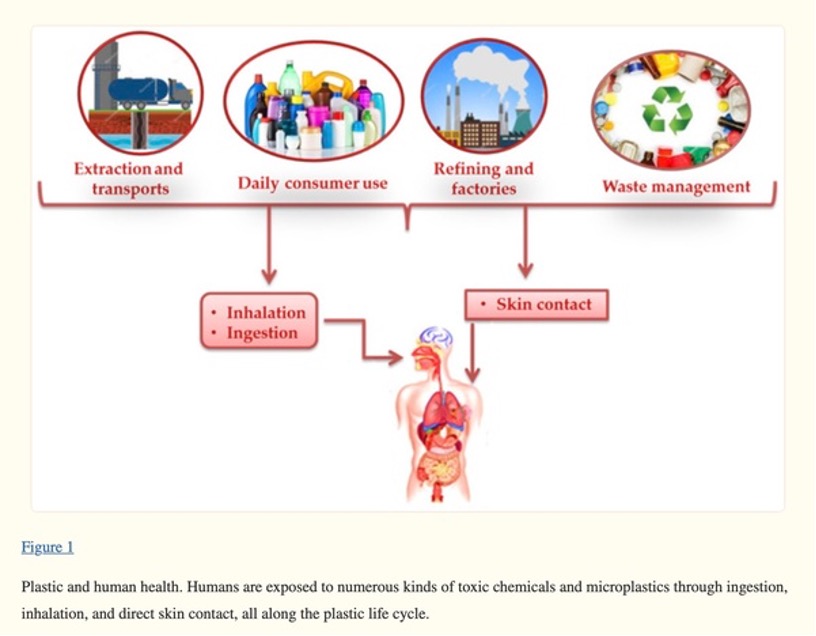Despite Being a Serious Threat to Human Reproduction, Plastics are Set to Shape the Future
Updated
Life on Earth now takes place in a cocktail of pollutants. Despite years of chatter about reducing plastic use, immediate global action is required to fix the plastic waste problem that has engulfed our planet and invaded our bodies. The harsh reality is that plastic usage in the United States alone has surged over the past four decades, with a staggering 85 percent of municipal plastic waste ending up in landfills—and essentially inside the cells of every living organism on this Earth. Indeed, numerous studies have warned that microplastics pollute our blood, fetuses, dairy, the meat we eat, and so on. Now, a recent study has established that microplastics and nanoplastics exist in every male testicle, raising urgent concerns about their impact on the human reproductive system. Yet, the use of plastic persists, and those in charge remain silent about its detrimental impact on our health.
A closer look at plastics reveals them to be synthetic organic polymers. Their production scale, long-term durability, and unsustainable usage, combined with inadequate waste management systems, have led to the proliferation of plastics in vital ecosystems around the globe. Plastic is now the most prevalent marine debris in our oceans and lakes, taking on various forms and sizes. However, the most alarming and immediate threat posed by plastic pollution is the fragmentation of plastic into smaller pieces, known as microplastics, or MPs. These environmental pollutants have been found literally everywhere, demanding our immediate attention and action.
Even scarier, they act as endocrine-disrupting chemicals (EDCs) and mimic the activity of endogenous steroid hormones, interfering with endocrine functions with different mechanisms. While infertility was once considered a “women’s problem,” it is on the rise in males, and semen quality has declined in recent decades. A March 2019 article in the Guardian titled “Sperm counts are on the decline—could plastics be to blame?” declared:
“Endocrine disruptors may also affect sperm in adult men. A 2014 study of the effects of 96 of those chemicals on human sperm found that they affected sperm’s ability to swim, navigate and fertilize an egg.”
Wonder why sperm counts are down and populations are decreasing? In the here and now, we know the tainted COVID jabs are wreaking havoc on reproduction, but plastic use has persisted and grown unchecked for years. Again, this is despite the regime’s awareness of countless decades-old studies outlining that microplastics (MPs) cause all living things to cease thriving, including human beings. It is well known that endocrine-disrupting, sperm-lowering BPAs are marked as absent in many products, leaving many to breathe a sigh of relief when they see “BPA Free” noted on their plastic product. But not so fast.
A 2022 research article in Cell Biology concluded that BPA’s replacement(s), BPF and BPS, “induce protumorigenic changes in human mammary gland organoid morphology and proteome.” In other words, BPF and BPS cause tumor initiation, tumor promotion, malignant conversion, and tumor progression in mammary glands as well as in the entire set of proteins that is or can be expressed by a genome, cell, tissue, or organism at a particular time. BPA alternatives are just as carcinogenic. Clearly, the problem is not BPA, BPF, or BPS—it is plastic in general, including PVC and PE—and the MPs they produce are deadly and are lowering sperm production. Tracy Woodruff, PhD, professor and director of Environmental Research and Translation for Health (EaRTH), commented after the recent Toxicological Sciences study confirming MPs in all testicles:
“This study evaluates the types of plastics found in the testis, and it is not surprising that PE is the most common—because PE is the most commonly produced plastic—it is used in plastic bags, bottles, food containers, carpet films, etc. Bottom line—if it is being produced then there is a good chance some of it is ending up in us and our pets. As for health effects—this adds further evidence to our work showing that MPs [microplastics] are suspected to adversely affect the male reproductive system.”
Indeed, for several years, research has indicated that MPs are lowering sperm counts. Yet here we are again—it’s as if the destruction is on purpose. Why aren’t our taxpayer-funded health agencies clearly warning us and taking immediate action? As bright as these people claim to be, the use of these non-biodegradable materials should have ended decades ago. Yet, we shouldn’t be surprised that they haven’t. Look around. As evidence mounts on the deadly dangers of mRNA gene therapy drugs (yes, I state this in nearly every article), these same people also stay silent and quietly regroup every time their game comes close to being fully exposed.
Again, MPs act as a vector for environmental pollutants and are endocrine-disrupting chemicals (EDCs), mimicking the activity of endogenous steroid hormones and interfering with endocrine functions. They are unknowingly ingested by humans and animals in food and water and then massively accumulate in human tissues, including male testes. This slow poisoning is not acceptable—but yet it is happening at a rapid pace. A study from March 2021 titled “Microplastics: A Threat for Male Fertility” stated:
“Recent studies revealed the deleterious effects of MPs exposure in male reproduction and sperm quality, making them a potential hazard to reproductive success.
MPs have been detected in human stool, cancer specimens, and placenta, highlighting the possible risk for disease load, successful pregnancy, and in utero transmission to the offspring.”
Since 1950, humans have produced over 8 billion tons of non-biodegradable plastic. More than half of that went straight to landfills; only roughly 9 percent was recycled. Even in landfills, plastic leaches toxic chemicals into the soil and groundwater and chokes or poisons animals who unwittingly ingest it. Microplastics have popped up in rivers, oceans, soil, food, tea, and even Antarctic snow—and now these tiny plastic particles are showing up in clouds, as reported by the Washington Post. Researchers from Waseda University in Tokyo even found microplastics in the clouds above Mount Fuji. In a paper published in Environmental Chemistry Letters, the researchers wrote that these airborne microplastics could influence cloud formation—and, in turn, the climate.
For those currently pushing the climate change agenda fueling the Great Reset, why neglect for years mentioning the documented harm that plastics have inflicted upon all living things on Earth? The same group making millions off policies and back-door agreements that ultimately keep us sick doesn’t make a peep about plastics until it serves their agenda. Meanwhile, again, plastic has been around for decades, wreaking havoc on Earth and our health. Yet for years, when studies suggesting plastics negatively influence fertility pop up, “more research is needed” is often the main takeaway. The latest study is significant and reinforces once and for all that something must be done before human reproduction (and other life forms) becomes non-existent.
Presently, the global elite are indeed finally talking about plastic. But, instead of talking about the dire health-related ramifications of MPs, the focus of the World Economic Forum, United Nations, and others is in on the contribution plastic makes to the “triple crisis” that faces our planet: the depletion of natural resources and the destruction and pollution of the environment. Since plastic production needs fossil fuels, they are ready to push hard to revamp plastic and use toxic biomass as part of the solution. No, they are not focused on using hemp plastic, although it seems like a good alternative. But rest assured, a new revenue stream is on the horizon for the global elite—whomever they are—as well as a push closer to the ultimate objective.
Plastic is part of the plan, don’t you see? Unfortunately, despite inflicting grave harm on our bodies, it is not easily going away. Without question, it is the material of the new future. Like clockwork, a team of scientists from Germany, Switzerland, and the United States recently unveiled a plan to move towards net-zero greenhouse gas emission plastics by a circular carbon economy. They explain that the raw material combination of biomass, CO2, and recycled waste can produce plastic with net-zero emissions using “emission-free” wind power.
Still, it is already well established that burning biomass for fuel (biomass-burning power plants already generate electricity on a large scale in the US) produces deadly particle pollution. Will plastic be safer for the Earth if we replace fossil fuels as the hydrocarbon source and use only renewable “raw” materials like waste biomass and carbon dioxide? That aspect of the new world of plastic is ignored. Instead, the sinister World Economic Forum noted that “experts expect [plastic] consumption to triple again by 2050.” But again, no mention of the dire threat plastics present to human reproduction, the WEF shared:
“Plastics shape and facilitate the whole of modern life. They are found in everything from smartphones to shoe soles, in spectacle lenses and mattresses, in footballs and fridges. What is more, plastics are a key part of our efforts to create a truly sustainable world. Without them, no windmill turns, no electric car drives, and houses would consume much more energy. Water would seep away, and much of the harvest would not be available to feed the growing world population.”
The fact that MPs were found in every testis does not matter. Make no mistake: saving the planet is not the ultimate goal; fewer people walking the Earth is the real agenda.








